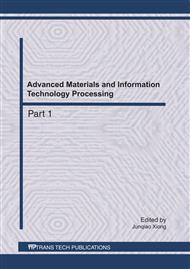[1]
Tom Stephenson, Allan Manand, John Upton. The small foot prints wastewater treatment process [J]. Chemistry & Industry: English Edition [ISSN 0253-2417], 1993, 19(4): 533.
Google Scholar
[2]
Gilbert Desbosand Frank Rogalla. Biofiltration as a compact technique for small wastewater treatment plant [J]. Water Science & Technology [ISSN 0008-8994]: English Edition: 1990, 22(3): 145.
Google Scholar
[3]
Metcalf & Eddy, Inc. Wastewater engineering treatment and reuse [M]. McGraw-Hill Companies, Inc, 2003: 65-67.
Google Scholar
[4]
Bruce Willey, Yves Coquet and Leonard Audoin. Innova Tiv nitrification technique introduced at treatment plant in France [J]. Water Environment & Technology: English Edition [ISSN 1044-9493], 1993, 9(1): 54~60.
Google Scholar
[5]
R. Pujol. Improvements for Upflow Submerged Biafilters[J]. Water Environment & Technology: English Edition [ISSN 1044-9493], 2000, 16(4): 25-29.
Google Scholar
[6]
M. Payraudeau, C. Paffoni, M. Gousailles. Tertiary Nitrification in an upFlow Biofilter on Floating Media: Influence of Temperature and COD Load [J]. Water Science & Technology: English Edition [ISSN 0008-8994], 2000, 41(4): 21-27.
DOI: 10.2166/wst.2000.0420
Google Scholar
[7]
Capdeville B, Nguyen K. M, Rose J.L. Biofilm modeling: Structural, reactional and diffusional aspects, Biofilms-Science and Technology [M]. New York: Kluwer Academic publishers, 1992, 251-276.
DOI: 10.1007/978-94-011-1824-8_23
Google Scholar
[8]
Capdeville B, Nguyen K.M., Kinetics. Biofilm modeling of aerobic and anaerobic film growth [J], Water Science & Technology: English Edition [ISSN 0008-8994], 1990, 22(3): 149-170.
DOI: 10.2166/wst.1990.0144
Google Scholar
[9]
Liu Y. Estimating minimum fixed biomass concentration and active thickness of nitrifying biofilm [J]. Water Environment & Technology: English Edition [ISSN 1044-9493], 1997, 123(1): 198-202.
DOI: 10.1061/(asce)0733-9372(1997)123:2(198)
Google Scholar
[10]
Liu Y, Chen G.H. A model of energy uncoupling for substrate-sufficient culture [J]. Bio-technology: English Edition [ISSN 1110-7243], 1997, 55(3): 571-576.
Google Scholar
[11]
Bird R. B, Stewart W. e, Lightfoot E.M. Transport phenomena [M]. New York: John Wiley & Sons Inc, 1960: 23-45.
Google Scholar
[12]
Levenspiel O. Chemical reaction engineering [M]. New York: John Wiley & Sons Inc, 1962: 57.
Google Scholar
[13]
Hoehn R.C. and Ray A.D. Effects of thickness an bacterial film [J]. Wat. Pollut. Control Fed: English Edition [ISSN 0049-6979], 1973, 45(3): 230-232.
Google Scholar
[14]
Atkinson B, Daoud I.S. The analogy between microbiological reactions and heterogeneous catalysis [J]. Trans Instn Chem Eng.: English Edition [ISSN 0438-1157], 1968, 46(3), 19.
Google Scholar
[15]
Atkinson B, Fowler H.W. The significance of microbial film in fermenters[J]. Adv. Biochem. Eng. : English Edition [ISSN 0003-2697], 1974, 11(3): 221-277.
Google Scholar
[16]
Atkinson B, Rahman F. Effects of diffusion limitations and floc size distributions on fermenter performance and interpretation of experimental data[J]. Biotechol Bioeng : English Edition [ISSN 0736-6205] , 1979, 21(2): 221.
DOI: 10.1002/bit.260210209
Google Scholar


